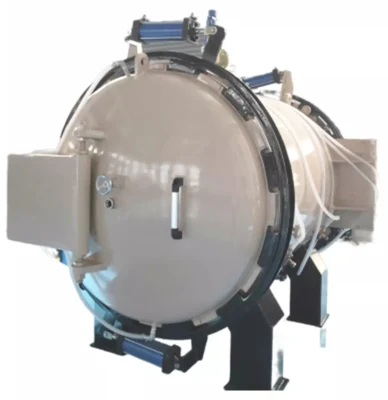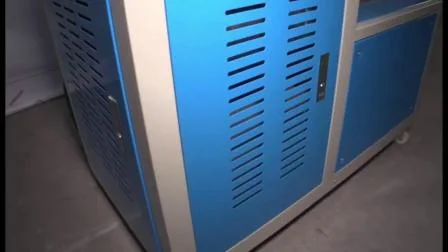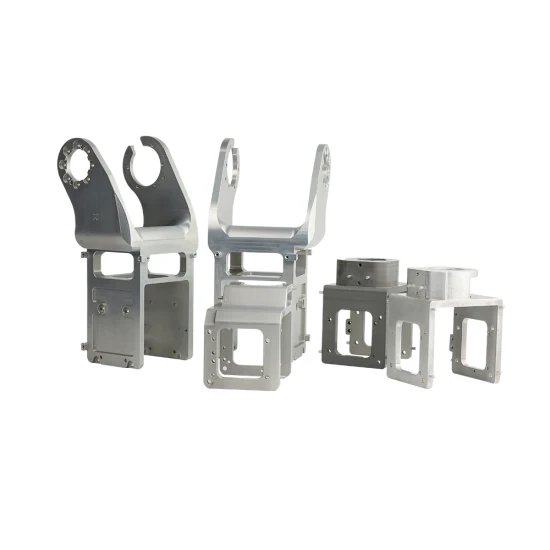
Metal Matrix Composites, Mmcs
Basic Info
| HS Code | 8514109000 |
| Production Capacity | 100 Sets/Year |
Product Description
Metal matrix composites (MMCs) mainly refer to a kind of composite material which is made of metal and alloy as matrix material and high strength materials such as fiber, whisker and particle as reinforcement.
The common preparation methods of MMCs are: powder metallurgy, in-situ synthesis, spray forming, casting solidification and so on. According to the different reinforcement phases, they can be divided into continuous fiber reinforced (mainly carbon and graphite fiber, silicon carbide fiber, boron fiber, alumina fiber, stainless steel wire and tungsten wire), discontinuous fiber reinforcement (including SiC, alumina, boron carbide particles reinforcement, silicon carbide, aluminum oxide, equal whisker reinforcement, alumina fiber and other short fiber reinforcement) and laminated composite Materials.
Vacuum sintering furnace (left) and vacuum hot pressing furnace (right) independently developed by Shanghai Haoyue
Because the introduction of reinforcement phase can change the microstructure and microstructure of the matrix material to a certain extent, such as substructure, dislocation morphology and grain size, so as to improve and make up for the defects in some properties of the matrix materials, so that MMCs have high specific strength and specific modulus, high temperature resistance, corrosion resistance, small thermal expansion coefficient, strong dimensional stability, good conductivity and thermal conductivity Physical and mechanical properties. Therefore, MMCs have replaced some traditional materials and gradually become the focus of material science research at home and abroad.
Application of metal matrix composites
Copper is one of the earliest and most practical metals discovered by human beings. Because of its excellent ductility, it is second only to silver in electrical conductivity and second only to gold and silver in thermal conductivity. However, the mechanical properties (wear resistance, hardness, strength, creep resistance, etc.) of copper are poor, which limits the application of copper in industry and military fields. Among many MMCs, copper matrix composites have been widely concerned for their excellent conductivity, thermal conductivity, corrosion resistance and good processability. Since the 1960s, the research on copper matrix composites has been carried out gradually. Many scientists have added different reinforcements into the copper matrix. It is found that the composite not only keeps the advantages of copper, but also makes up for the deficiency of copper mechanical properties. Up to now, the research of copper matrix composites has lasted for several decades, forming three categories: particle reinforced copper matrix composites, fiber reinforced copper matrix composites and whisker reinforced copper matrix composites.
Application of copper matrix composites
1. Particle reinforced copper matrix composites
The purpose of particle reinforced copper matrix composites is to disperse particles with excellent properties uniformly in copper matrix and improve the comprehensive properties of copper matrix composites. The pinning effect of particle reinforced phase can greatly hinder the movement of dislocations, so as to enhance the strength of the composite, and greatly improve the mechanical properties, wear resistance and high temperature properties of copper matrix composites. In addition, due to the small amount of particle reinforced phase, the original high conductivity and thermal conductivity of the matrix material will not be significantly reduced. The common particle reinforced phases are Al2O3, WC, TiB2, Ti3SiC2, etc. At present, the most studied is Al2O3. Due to its high mechanical properties, electrical conductivity and thermal conductivity close to pure copper, and also have good corrosion resistance and wear resistance, the composite has entered the practical stage. WC particles are characterized by high strength, high hardness, high melting point and high elasticity, so WC reinforced copper matrix composites also have high strength, high hardness, high conductivity and thermal conductivity. TiB2 particles are characterized by excellent stiffness, high hardness and good wear resistance, so TiB2 reinforced copper matrix composites have excellent stiffness, hardness and wear resistance. Ti3SiC2 is a new type of material, which has excellent structure, conductivity and self-lubricating properties. It has the same characteristics as metal materials in conducting, conducting and processing. At the same time, it has the characteristics of light weight, oxidation resistance and high temperature resistance of ceramic materials. Therefore, Ti3SiC2 reinforced copper matrix composite is an excellent self-lubricating material, and its mechanical properties are better than that of SiC reinforced copper matrix composite.
Due to the combination of metal and nonmetal properties (strength and toughness, wear resistance, heat resistance, electrical conductivity and weather resistance), particle reinforced copper matrix composites can be widely used in engineering requirements, and its specific strength, specific modulus and high temperature stability are better than the matrix materials, which plays an important role in the development of aerospace and other cutting-edge fields.
2. Fiber reinforced copper matrix composites
Fiber reinforced copper matrix composite is a method to strengthen copper matrix by using high strength metal wire or fiber (diameter 3 ~ 5 μ m), which is also the first strengthening method applied to copper matrix composites. Fiber reinforced copper matrix composites have been widely used in aerospace, automotive, electronics and other fields because of their high temperature resistance, excellent electrical conductivity, thermal conductivity, fatigue resistance, and excellent dimensional stability in radiation and humidity environment. The properties of fiber reinforced copper matrix composites are determined by the properties of fibers. The fiber reinforced phase is required to have high aspect ratio, high specific strength, high specific modulus, stable high temperature oxidation resistance and good electrical and thermal conductivity. At present, B fiber, C fiber, SiC fiber and Al2O3 Fiber should be widely used. B fiber has the characteristics of low density, large aspect ratio, high elastic modulus, high thermal conductivity and excellent thermal stability Compared with B and C fibers, SiC fiber has better high temperature performance and better oxidation resistance than B and C fibers. Therefore, SiC fiber is mainly used in the manufacture of various high temperature resistant and high performance structural parts of aircraft, missiles and engines.
3. Whisker reinforced copper matrix composites
Whisker reinforced copper matrix composite is a method which is mainly beneficial to whisker reinforced copper matrix composites. Fine needle like crystals without defects (i.e. there is only one screw dislocation on the growth axis) are called whiskers; generally, the aspect ratio is greater than 10 and the cross-sectional area is less than 52 × 10-5 cm-2. Now, short fiber dimensional crystals are also considered as a kind of whiskers. As a result, the strength and modulus of the whisker are close to the theoretical calculation value of the complete grain boundary material, so the whisker reinforced phase becomes a kind of strengthening and toughening phase with excellent mechanical properties, which can significantly improve the wear resistance, corrosion resistance and thermal fatigue resistance of the composite
The expansion coefficient of the material is reduced. Therefore, synthesis and application of whiskers have become a hot research field in materials science. After years of research and development, more than 100 kinds of whiskers have been formed, mainly composed of SiC, Si3N4, K2Ti6O13, Mg2B2O5, al18b4o13, Al2O3 and ZnO. Among all whiskers, SiC whisker is known as "the king of whiskers", which is the key field of research and application. Because SiC whiskers have the highest strength, elastic modulus, tensile strength, heat resistance and other properties of all the synthesized whiskers. Similar to SiC, Si3N4 whiskers have lower hardness but better machinability. The K2Ti6O13, al18b4o13 and Mg2B2O5 whiskers developed in the later stage are not only excellent in performance, but also cheaper.
According to the market demand, Haoyue Technology continuously develops and improves technology, introduces heat treatment equipment with excellent performance, and provides corresponding technical support to assist domestic composite market and provide corresponding technical consultation for heat treatment process of composite material industry.
Haoyue Technology is a high-tech enterprise integrating R & D, production and sales of electric furnace. The company has been focusing on advanced ceramics and composite materials, semiconductor materials, carbon materials, lithium batteries and new energy materials equipment four major fields, has rich industry experience and professional technology, wholeheartedly serves customers and provides perfect integrated industrial solutions.






